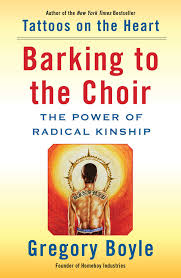Barking to the Choir: The Power of Radical Kinship
By Gregory Boyle
–Review by Landrum P. Leavell III, Th.D.
If you haven’t read Father Gregory Boyle’s first book, Tattoos on the Heart, you’re behind. This Jesuit priest, known to homies as “G-Dog,” has worked with gang members in Los Angeles for three decades. His first book introduced us to Homeboy Industries, the largest gang-intervention program in the world. (All the net proceeds of this book are donated to Homeboy Industries. HomeboyIndustries.org)
Tattoos was deemed by the Los Angeles Times as “destined to become a classic of both urban reportage and contemporary spirituality.” This second book reveals how compassion is transforming the lives of gang members. You get a series of snapshots into the challenges and joys of life on the margins. The stories from real life throughout the book are riveting, powerful, and inspiring. We get glimpses of life for many who from an early age “realize how thrown away they are.” (180)
Know going in that this book is real. It’s not a G-rated book. It’s R-rated. Real-life. Relational. Redemptive. You’ll get a few, candidly refreshing F-bombs. [If you haven’t heard one in a while, I’d check how far away from the mission field-real world you are.]
Father G has made a practice for years of taking homies with him to speaking events, both near and far. The majority of them have never been on a plane. He lets them tell their stories, which both shock and awaken audiences to the world most of them will never enter. At one event, a homie, speaking to a city council meeting as if they were stand-ins for all of society, said “You gave up on me even before you knew me.” (166)
These snapshots give readers a whole new definition of the phrase “uphill battle.” Broken homes, abandonment, foster care, homelessness, growing up on and in the streets—day-to-day realities are more the norm than the exception. From a pastoral perspective, the street cred of Father Boyle is likely without equal. When he wrote Tattoos on the Heart five years ago, he had buried 168 gang members. As of the writing of Barking to the Choir, he had buried 220. And these are all men and women he has known, walked with, and loved. Unfathomable.
Thankfully, there are stories of challenges met, destinies reversed, and families rebooted as generational sin, trajectories, and failures of the past are transformed by gospel-soaked compassion and kinship. Homeboy has become the home and family that many never knew was possible. Knowing that the dozens, if not hundreds of stories, are just the tip of the iceberg is almost beyond one’s ability to grasp.
Boyle graces us with pictures of those we’ll never meet (or maybe we will). He describes one gang member as having “the light grasp of a saint, freed from the attachments that encase our suffering. He has a taste of what it’s like not to be destroyed and liberated from all clinging and fear.” (45) He reminds us that, “being alert to the sacred in our midst is a choice that gets more meaningful as we practice it.” (40)
This guy is both faithful and fearless. One night he was riding his bike in the Pico Gardens Housing Project and spotted a sixteen-year-old gang member sitting alone. Kindness was this kid’s hallmark. When Father G asked him what he was doing, he said matter-of-factly, “Praying. In fact, I asked God just now to give me a sign that He’s as great as I think He is. Then you showed up. Proof!” (38-9)
This is a continuation of a long-haul story. Over thirty years, slogging through the muck and mire of insurmountable odds. Without all the true stories of transformation, you would never bet that a Jesuit priest in the bowels of L.A. could start and sustain the largest gang intervention, rehab, and reentry program in the world. In his own words: “See something. Say something. They’ll believe you. The time for any of us to be returned to ourselves is now. The ground beneath our feet is the Kingdom of God, the Pure Land. It’s not around the corner; it is the corner. Kinship is not a reward bestowed at the end. It’s here, it’s now, it’s at hand and within our reach. And this moment is the only one available to us.” (90)
If you want a book that will simultaneously awaken your heart, warm your heart, break your heart, and rekindle your heart for those on the margins likely living pretty close to you, get this one. I have no idea how the whole sainthood thing works in the Catholic Church, but I cannot see how Father G-Dog wouldn’t someday make the cut.
He’ll surely hear the words, “Well done, good and faithful servant.”


Wonderful review, Lan! Thanks. Also, is the Th.D. after your name for Doctor of Thinkology – just wondering…